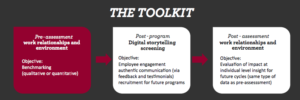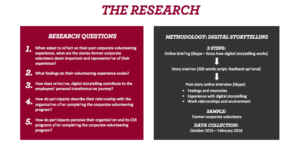
Executive Summary:Â
Corporate volunteering is an important vehicle for delivering care and compassion to causes and communities in need (Grant, 2012: 589). Identified by Bussell and Forbes (2008) as the fastest-growing area of volunteering in North America and Western Europe, corporate volunteering is being adopted more readily by organizations and their employees as it is often perceived as a more important form of corporate social responsibility (compared to philanthropic contributions for instance JA Worldwide, 2009) (Paolo & Nave, 2013; Peloza, Hudson & Hassay, 2009) and indirectly as a stronger contributor to a company’s reputation and employer brand.
Under ideal circumstances, corporate volunteering can create a win-win situation for all parties involved: public welfare is achieved while the state is relieved; the image of a company is ameliorated while costs for personnel and organizational development are outsourced; employees improve their skills while being paid and valued by their employer (Van Chie, Guentert & Wehner, 2011: 122). Additionally, employee volunteering has been linked both with increasing job meaningfulness, job absorption (Rodell, 2013), professional development (Green et al, 2012), and increased employee commitment to the organization (Brammer, Millington and Rayton, 2007), as well as with being a practice that was credited by supervisors and co-workers alike when it was attributed to intrinsic motives (Rodell & Lynch, 2016).
Despite the growing investment and interest in corporate/employee volunteering, there is a disconnect between what the organizations and employees, both when it comes to goals and outcomes. More importantly, an integrated approach that links employee expectations of volunteering with the organizations volunteering/CSR objectives and integrates that insight into evaluation of the volunteering program both by employees and the organization is currently missing.
This paper aims to address this void by proposing a toolkit for effective evaluation of corporate volunteering programs using digital storytelling.
In doing so, the paper presents the methodology of a study using digital storytelling reflecting the experiences of corporate volunteers, discussing its setup and its limitations. In criticizing the self-serving and risk-averse reception of the study among corporate communication/CSR managers and reflecting over the high dropout rate of the online-only study, the authors propose a toolkit for the assessment of corporate volunteering experiences going beyond the use of digital storytelling. The toolkit features three steps: participant assessment of their work environment and their work relationships prior to joining the corporate volunteering program, digital storytelling screening and post-volunteering participant assessment of their work environment and their work relationships.

As corporate volunteering activities could affect an organization’s image, employer brand perception and organization’s reputation, we deem corporate volunteering (whether recruitment into the program, program progression, results of the program or personal outcomes) to be strongly linked with communications.
We argue that the methodology that we present here, although tested on a matter related to corporate volunteering, can be expanded and applied to other areas of communications spanning from internal communication, employer branding, or stakeholder engagement just to name a few. Moreover, we argue that digital storytelling as a methodology and evaluative practice of communications activities has only few known implementations into practice and even fewer into academic literature. Most of the known research and application present storytelling as an integral tool to (corporate) communications, performed and created by communicators (see Adi, Crisan & Dinca, 2015a; Dobers & Springett, 2010; Gill, 2011; Kent, 2015; Shamir, 2005).
Our digital storytelling toolkit and its associated pre and post-program evaluation, enable practitioners and researchers to become curators, facilitators and perhaps co-creators of stories. This, we believe, it is highly necessary in a time when peer-to-peer communications are either preferred or paid more attention to.
